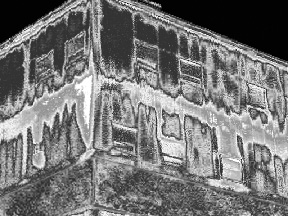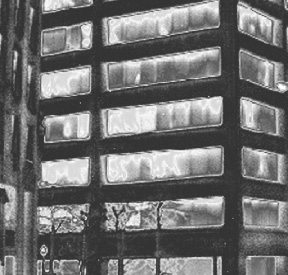With today's escalating energy costs and pressing concerns about environmental impacts and sustainability, improving the building's energy performance is an important objective for any renovation or rehab project. Good pre-project planning is essential to developing practical and cost-effective retrofit strategies. Unless you have an understanding of the actual energy performance of the existing building, there's a good chance that the time and money invested will not produce the energy savings you expect -- and may even make things worse.
Where is warm air escaping from the building? Where is cold air coming in? Is the insulation in that wall functioning well? Or has it settled, or suffered water damage, or...is it even there? Are there conditions that could encourage mold growth? Which windows are failing? What are the most cost-effective steps to improve the building's energy performance? What needs attention? What already works well?
Fortunately, it is now possible to answer these questions in "real time" using infrared thermography. Using this cutting-edge nondestructive technology, an experienced certified thermographer can pinpoint all the significant sources of heat loss in the building envelope. Infrared building envelope analysis provides a virtual road map for planning and integrating the most appropriate and cost-effective energy saving measures in your renovation or rehab project.
The importance of understanding the existing conditions was illustrated recently when we conducted a thermographic evaluation of a large performing arts center in New York City. The original 100-year old masonry portions of the building were performing surprisingly well, but when we inspected newer sections of the building we found serious problems. In many areas, the newer walls performed so poorly that the windows were actually transferring less heat than substantial portions of the fully insulated wall systems. Armed with our test results and analysis, the building owners had a much better understanding of the steps required to cost-effectively improve their facility's energy performance.
Infrared testing can also locate and document problems in newly renovated structures. In one such case, we were asked to perform forensic thermographic testing of a stately old university building that had been recently renovated. Once construction was complete and the occupants moved in, they found their offices were uncomfortably cold when temperatures started dropping in the fall. By mid-winter, the sprinkler pipes were bursting, causing tens of thousands of dollars of water damage to three floors of the building. Our infrared scanning revealed that there had been a substantial misunderstanding of the initial condition of the building envelope. Significant insulation voids were allowing cold penetration of the walls and attic, dropping interior temperatures and causing freeze ups. When you make infrared testing the first step in developing a comprehensive renovation or rehab plan, you can avoid these types of disasters.
Would you like your renovation project to be officially recognized for its energy saving performance? Many building owners are now incorporating infrared inspections in their plans to seek LEED Certification for their existing buildings.
Whatever your renovation or rehab plans, getting an accurate picture of the building's thermal performance beforehand is critical to avoiding expensive surprises and disappointing results. Infrared building envelope analysis provides this information so you can develop plans based on actual conditions, rather than assumptions. For any project, large or small, that's a big step toward realizing substantial ongoing energy savings and achieving a trouble-free, cost-effective outcome.
Peter Brooks is principal of Infra-red Analyzers, Inc., Williston, VT.
.png)









